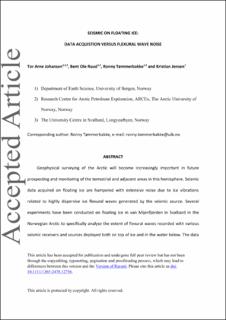| dc.contributor.author | Johansen, Tor Arne | |
| dc.contributor.author | Ruud, Bent Ole | |
| dc.contributor.author | Tømmerbakke, Ronny | |
| dc.contributor.author | Jensen, Kristian | |
| dc.date.accessioned | 2021-04-20T13:50:42Z | |
| dc.date.available | 2021-04-20T13:50:42Z | |
| dc.date.created | 2019-06-14T19:14:26Z | |
| dc.date.issued | 2019 | |
| dc.Published | Geophysical Prospecting. 2019, 67 (3), 532-549. | |
| dc.identifier.issn | 0016-8025 | |
| dc.identifier.uri | https://hdl.handle.net/11250/2738713 | |
| dc.description.abstract | Geophysical surveying of the Arctic will become increasingly important in future prospecting and monitoring of the terrestrial and adjacent areas in this hemisphere. Seismic data acquired on floating ice are hampered with extensive noise due to ice vibrations related to highly dispersive ice flexural waves generated by the seismic source. Several experiments have been conducted on floating ice in van Mijenfjorden in Svalbard in the Norwegian Arctic to specifically analyse the extent of flexural waves recorded with various seismic receivers and sources deployed both on top of ice and in the water below. The data show that flexural waves are severely damped at 5 m or deeper below the ice and hydrophone data suffer less from these vibrations compared with data recorded on the ice. Aliasing of single receiver hydrophone data can to some extent be suppressed using an in‐line line source of detonating cord. Experiments on ice on shallow water show prominent guided wave modes often referred to as Scholte waves propagating along the seabed. In this case, both flexural and Scholte waves interfere and make a complicated pattern of coherent noise. On shallow water, the positioning and type of the seismic source must be evaluated with respect to the coherent noise generated by these waves. Geophone strings of 25 m effectively suppress both flexural and Scholte waves due to their relative short wavelengths. An airgun generates relative more low‐frequency energy than a surface source of detonating cord. Accordingly, seismic mapping of deep seismic horizons seem to be best achieved using geophone strings of such length and an airgun source. For shallow targets, the use of hydrophones in combination with detonating cord is an appropriate solution. Seismic surveying in the Arctic always have to follow environmental restrictions of not disturbing or harming wildlife and not causing permanent footprints into the vulnerable tundra, which implies that the choice of seismic acquisition strategy might occur as a trade‐off between optimum data quality and environmental constraints. | en_US |
| dc.language.iso | eng | en_US |
| dc.publisher | Wiley | en_US |
| dc.title | Seismic on floating ice: data acquisition versus flexural wave noise | en_US |
| dc.type | Journal article | en_US |
| dc.type | Peer reviewed | en_US |
| dc.description.version | acceptedVersion | en_US |
| dc.rights.holder | Copyright 2019 European Association of Geoscientists & Engineers. All rights reserved. | en_US |
| cristin.ispublished | true | |
| cristin.fulltext | postprint | |
| cristin.qualitycode | 1 | |
| dc.identifier.doi | 10.1111/1365-2478.12756 | |
| dc.identifier.cristin | 1705109 | |
| dc.source.journal | Geophysical Prospecting | en_US |
| dc.source.40 | 67 | |
| dc.source.14 | 3 | |
| dc.source.pagenumber | 532-549 | en_US |
| dc.relation.project | Norges forskningsråd: 228107 | en_US |
| dc.identifier.citation | Geophysical Prospecting. 2019, 67 (3), 532-549. | en_US |
| dc.source.volume | 67 | en_US |
| dc.source.issue | 3 | en_US |
